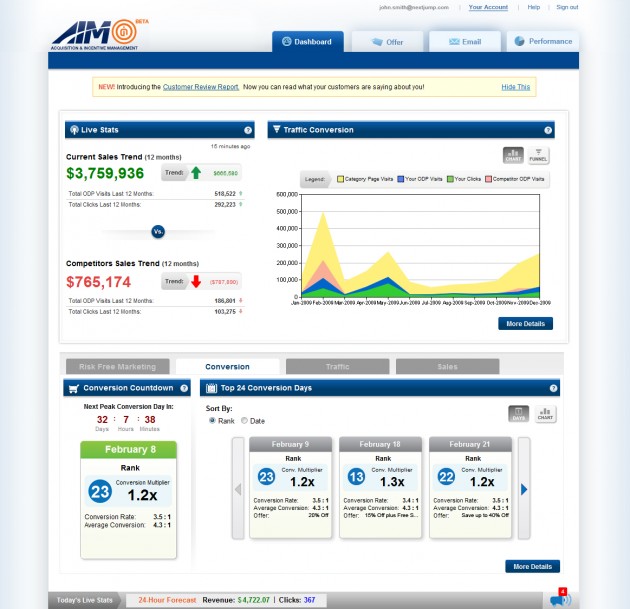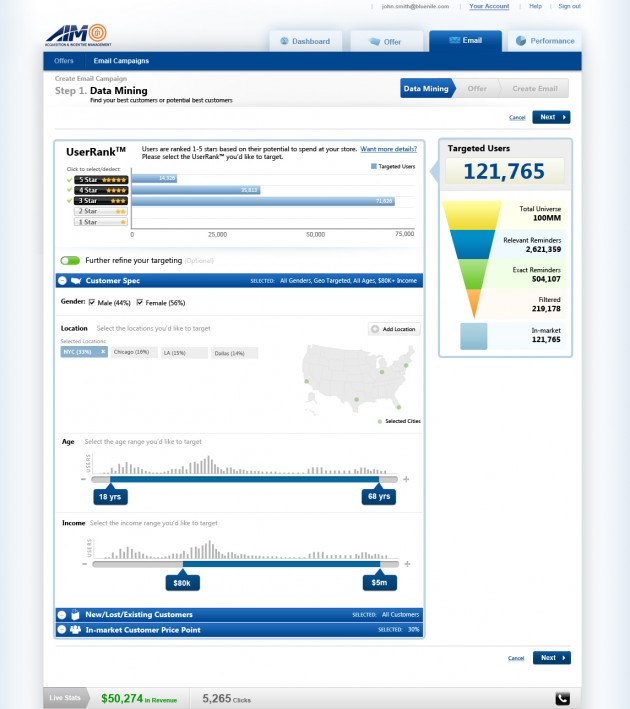
In the annals of stealth startups, Next Jump deserves its own chapter. It’s not often that a company can build a large and successful business for 15 years, raise $45 million in venture capital, hire 225 people, and sign up 60 percent of the Fortune 500 as customers without anybody ever hearing about it. Yet that is exactly what Next Jump did until the first story ever written about the company appeared in the New York Times last month. The $45 million came over the course of 8 rounds and all from angel investors, including early Google investor Ram Shriram and Deutsche Bank asset management chief Kevin Parker (who are both board members).
The company is now coming out of its shell, partly because it is so big that it can no longer hide. “Our thought was to stay quiet until it feels like we had an elephant under a hay stack,” CEO and founder Charlie Kim tells me during a recent visit to Next Jump’s Manhattan headquarters, which take up two floors of a downtown office building. Next Jump runs perhaps the largest set of direct merchant offers businesses in the world, making the growing preponderance of offers in social games seem primitive by comparison. It operates employee discount and reward programs on behalf of 90,000 corporations, organizations and affinity groups which reaches more than 100 million consumers.
Next Jump connects 28,000 retailers and manufacturers to these consumers, typically getting the merchants to offer deep discounts to its members. In Kim’s eyes, this is a much better way to advertise. His pitch to merchants everywhere is this: “Take your ad budget and use it to lower prices for targeted sets of customers. The user is in market, and conversion rates are through the roof.” According to Kim, Next Jump’s conversion rate on offers is 11 to 1, compared to 1000 to 1 or worse for typical Internet ad conversion rates.

In addition to Fortune 500 companies, it also runs rewards programs for the AARP, NEA, Dell, Borders, Hilton, and Mastercard, and reaches consumers directly through Overwhelming Offers (which is also an iPhone app) and small businesses through Corporate Perks. It also powers Yahoo’s Daily Deals. And Kim says that Next Jump drives more transactions than any other affiliate to Linkshare, Commission Junction, and the Google Affiliate Network. It derives revenues from corporations on a per-employee basis, as well as from merchants via transaction and advertising fees (for sponsored slots on its various deals Websites).
Next Jump’s origins are in local merchant coupon books for corporations and running corporate discount programs for their employees. It started out as a print catalog business out of Kim’s Tufts dorm room in the mid-1990s. By 1997 it went completely online because print costs kept going sky-high as merchants demanded the ability to update their offers more frequently. On the Web they can update them hourly if they want, and the feedback loop of what works and what doesn’t helps them fine-tune their offers accelerate the rate of transactions triggered by the deals.
It’s a data-driven business, which is what attracted Shriram to invest and become a board member in 2006—the last time the company raised money. (Shriram used to be the president of comparison shopping engine Junglee before it was sold to Amazon a dozen years ago). Shriram tells me:
It is about the Data, and building the data model is what takes time. Next Jump had to find a model that was a win-win for merchants and consumers alike that can scale. Through a process of trial and error and course corrections they ended up in a good place based on results I’ve seen—namely, users, user engagement and the participation of large employers in the program.
Next Jump has three very rich sources of data which it uses to target offers: a unique consumer demographic database, a transactional database, and a consumer preference database. “The consumer is reached through ‘buying circles’ inside their employer’s intranet,” explains Shriram. “We know most employees mostly shop on-line while at work. Businesses in turn, see special offers and attractive prices as a perk for their employees.”
Since it operates discount programs for roughly one third of all U.S. corporate employees, it is considered a non-traditional benefits provider and gets updated weekly on the employment status of 30 million workers (who also happen to be consumers). It gets part of the employee record, including things like name, address, employment status, home and work address, marital status, and sometimes even job title or salary grade. While it doesn’t have access to actual salaries, it knows enough to put people in the right buckets. “Income is the single largest predictor of future purchases,” says Kim, which makes sense. The more money you have, the more likely you are to spend some of it. But even Amazon doesn’t know your income other than what it can infer from your zip code.
Next jump gets transactional data from its merchants, credit card companies such as Mastercard, and affiliate purchases. But it’s preference database is perhaps the most interesting. Because it is seen as an employee perk, says Shriram, “HR departments inside companies and the individuals themselves are willing to engage in a level of preference data sharing that has not been seen in e-commerce before. The customer preference data allows for better targeting and ultimately superior conversions (around 10-11% vs 2% for the best commerce sites today).”
Consumers tell Next Jump not only what items they would like to buy, but at what price point they would be willing to buy it for. Across various of its services, consumers can set reminders for when specific products are available for deeper discounts. For instance, you can say alert me when I can buy this pair of Nike running shoes for a 40 percent discount instead of the current 20 percent discount. Next Jump collects all of this data and presents it to participating merchants in an online dashboard (see screenshots below) which helps them model demand at different discount points. The dashboard also shows them current sales, average sales for competitors, conversion rates, and helps them target by different age, income, location, whether they are new or existing customers, and other factors.
Every offer gets ranked and every user gets ranked. Next Jump’s OfferRank takes into account the discount price below retail, the quality of the offer as voted by users, and the performance history of that merchant as measured by click-through rates, purchase rates, average transaction size, and other variables. UserRank is based on how many reward points someone earns. You earn points every time you make a purchase. Retailers and manufacturers target their offers by UserRank above all other factors. The higher someone’s UserRank, the more they tend to shop.
Next Jump wants to match the best deals with the best shoppers. “Shopping and advertisng has always been the same to us,” says Kim. “Merchants are trying to connect with users and users are trying to connect with advertisers. It is a two sided problem.” Next Jump creates algorithms to reward not only good shoppers, but also good deals. Every time an opt-in offer email goes out, Next Jump measures the response rate. If someone stops responding that merchant is quarantined from that consumer. If the offers turn into spam, then everybody loses.
Merchants are willing to participate because the conversions are great, they get a lot of data to help them decide whether to step up their deals, and for the most part the deals aren’t terribly public so premium brands can use it as channel without diluting their premium pricing.
Kim knows his advantage lies with his data and improving the matches between buyers and sellers. That 11 to 1 conversion rate was 100 to 1 a year ago, and he wants to get it down to 3 to 1. In order to that, he needs better offer algorithms and is on an engineer hiring binge. Of his 225 employees, 150 are engineers. He hired 50 engineers last year, and plans to hire another 100 this year. Next Jump is one of the top engineering recruiters at MIT, Carnegie Mellon, and Georgia Tech.
If Kim keeps perfecting his shopping algorithms, you may never shop the same way again—and you won’t even know that you are doing anything differently .

